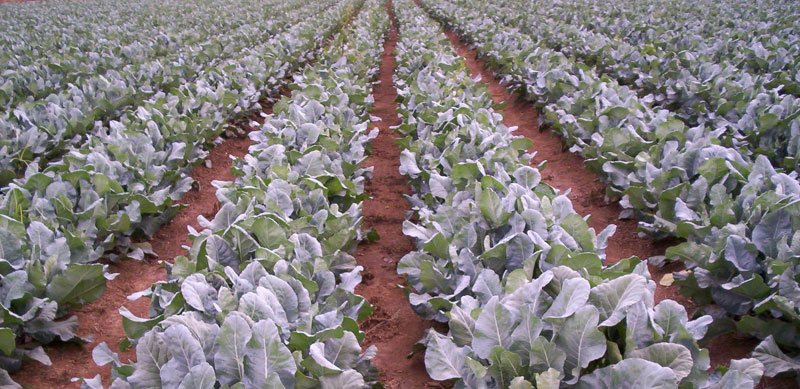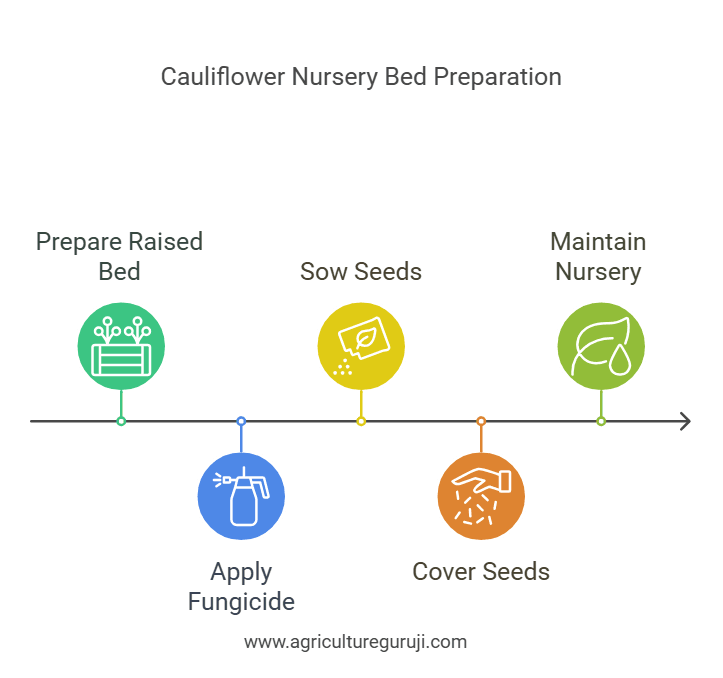Cauliflower is one of the most important winter vegetables grow in India. It is a European origin, probably develop from broccoli. In India, cauliflower farming is done in almost all the states, but the main states are Bihar, U. P., Orissa, Assam, M.P., Gujarat, and Haryana.
The scientific name of cauliflower is Brassica oleracea var botrytis. It has achieved importance as one of the important and popular vegetables in various parts of the world.
Cauliflower plays an important role in the human diet due to its attractive appearance, good taste, and nutritive rich value.
It is a rich source of protein, carbohydrates, vitamin-B, and C, and various minerals necessary for human health. Cauliflower is grown for its edible flowering head and consume as a vegetable in curries, soups, and pickles.
Climatic Requirements for cauliflower farming
 Cauliflower is a cool-season vegetable the best curds produces in the cool and slightly moist climate condition.
Cauliflower is a cool-season vegetable the best curds produces in the cool and slightly moist climate condition.
The optimum monthly average temperature ranges from 15 to 20 °C. The early varieties require higher temperatures and longer day lengths.
Soil
Cauliflower is cultivated on any good soil from clay to loamy, but the fairly deep loamy soil is most desirable. Soils with high moisture-holding capacity are preferred in late season/summer since water stress adversely affects curd development.
In the rainy season, soils that dry rapidly are preferred so that the cultural and harvesting operations can be done easily.
It is sensitive to high acidity, and the optimum soil pH for maximum production is 5.5 to 6.0.
Cauliflower is moderately sensitive to salinity in soil and water. It is more tolerant to salinity than lettuce but somewhat less tolerant to salinity than broccoli. Hence water with EC of 1.3 or less can be used for irrigation.
 Sowing Time
Sowing Time
The best time for seed sowing in the nursery depends on the climate, varieties, and temperature requirement for curd formation.
The cauliflower varieties are grouped under three categories. These are early season, main season, and late-season varieties.
Early-season varieties are sown from May to August and ready to harvest from September to December. Main season varieties are sown from September to October. They are ready for harvest from December to January, while late-season varieties are sown from October to December and harvested from mid-January to April end.
Cauliflower Varieties
- Early season – Early kunwar, Early Synthetic, Pusa Katki, Pant Gobhi-2, Pant Gobhi-3,
- Main season -Pusa Synthetic, Pant Shubhra, Punjab Giant-26, Punjab Giant-35
- late-season– Pusa Snowball-1, Pusa Snowball-2, Sonwball-16, Dania Kalimpong
Seed rate
For cauliflower cultivation in an Early season: 600g-750 gm/ ha, Mid and late season: 400-500 gm/ha seed required.
Nursery raising for cauliflower cultivation:

prepared raised bed for nursery a well rotten FYM or compost mix with soil at the rate 4 kg/m2.
Make Nursery beds one meter wide and fifteen cm in height.
After that, drench fungicide like Captan or Thiram at the rate of 2 g/l of water to prevent fungal diseases.
The seeds should be sown in lines at a spacing of 8-10 cm between rows and 1.5-2 cm between seeds at a depth of 1.5-2 cm. The seed should be covered with sand and FYM mixture.
Sowing of seed should be done at a distance of 8 to 10 centimeters between seedlings and 1.5-2 cm in the rows. Seeds should be covered with soil and FYM mixture.
During the monsoon, nurseries should be created under polyhouse or polytunnel. Weeding and intercultural operation should be from time to time. Nursery beds should always be irrigated according to need.
Transplanting
 Seedlings become ready for transplanting after 4 to 5 weeks.
Seedlings become ready for transplanting after 4 to 5 weeks.
During planting, the distance between the two plants depends on the soil’s fertility, Cultivation season, and market demand.
Generally, for the early season distance between plant to plant is 45 cm X 45 cm, and for the main season and late-season crop, 60 cm X 60 cm is maintained.
In the market, the demand for small and medium-size Cauliflower is generally high; therefore, more Cauliflower curds can be obtained by reducing planting distance.
An expert cauliflower farmer achieves this result by planting Cauliflower crop at the raw to raw 45 cm and plant to plant at 30 cm. You drip irrigation method for improving cauliflower yield.
Manure and fertilizer
The requirements of fertilizer and Manure for cauliflower crop is depended upon the fertility of the Soil. To determine the fertility of the soil, soil testing must be carried out before start cauliflower farming.
Before transplanting cauliflower crop, add 150-200 q/ha farmyard manure apply in the soil, and mix thoroughly in the field.
Generally, the cauliflower crop must give 200 kg of Nitrogen, 75 kg of phosphorus, and 75 kg potassium per hectare for optimum yield.
Nitrogen 100 kg, 75 kg phosphorus and 75 kg potash should be applied when transplanting. The remaining half of nitrogen should be given 30 and 45 days after transplanting.
Intercultural Operations in cauliflower farming
Weeding should be started as soon as the plants are set in the field. It should be shallow so as not to disturb the root system. To produce solid curds, cauliflower plants should be earthed up about 56 weeks after transplanting.
Special Cultural Practices
If the curds are exposed directly to bright sunlight, they lose some of their flavors and turn yellow; thereby, it a low-quality product.
Only perfect, milky white or snow-white curds get a good price hence Blanching operation carried out.
It consists of tying with twine or securing with a rubber band the tips of the outer leaves at the curd’s top. The curds should be left covered this way for a maximum of 45 days. This period can be extended to a week in severe winter or reduced to 23 days during hot weather.
Harvesting of cauliflower crop

Cauliflower crop is ready for harvest 90-120 days after planting.
The full white coloured matured cauliflower should be a harvest for sale immediately. If the harvesting is delayed, then the curds’ color is becoming yellowish, and its thickness and charm disappear. Therefore it is essential to remove the cauliflower at the right maturity time.
Cut stalk below to the curd with a knife. Grading should be made according to the colour and size, and market demand.
Normal temperature cauliflower can be stored for 3 to 4 days and below to 0 with 85 to 90% humidity in 30 days.
Yield of cauliflower
Cauliflower yield depends upon production season and breed varieties. for early varieties, approximately 6-10 t/ha is obtained while Midseason varieties yield 12-20 t/ha and for late variety, types are 20-30 t/ha obtain
In India year 2015- 2006, Cauliflower cultivated 426 ha an area, and the yield obtained is 8090 MT (source- NHB)





Usefull msg for formers
Thank you
very useful information. like to know more.
thank you